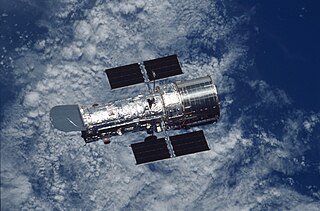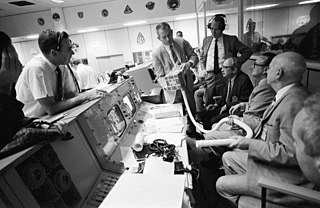Related Research Articles

Orbital mechanics or astrodynamics is the application of ballistics and celestial mechanics to the practical problems concerning the motion of rockets and other spacecraft. The motion of these objects is usually calculated from Newton's laws of motion and the law of universal gravitation. Orbital mechanics is a core discipline within space-mission design and control.

Astronautics is the practice of traveling beyond Earth's atmosphere into outer space. Spaceflight is one of its main applications and space science is its overarching field.
Dirk Brouwer was a Dutch-American astronomer.

Nguyễn Xuân Vinh was a Vietnamese-American aerospace scientist and educator. Vinh was Professor Emeritus of Aerospace Engineering at the University of Michigan, where he taught for nearly thirty years. His seminal work on the guidance, dynamics and optimal control of space vehicles and their interaction with the atmosphere played a fundamental role in space exploration and technological development.
Dirk Brouwer Award may refer to:
Robert M. L. Baker Jr. is an American physicist. He earned a bachelor's degree in physics at UCLA summa cum laude, was elected to Phi Beta Kappa, and earned a master's degree in physics and a Ph.D. in engineering at UCLA. The Ph.D. in engineering, with a specialization in aerospace, was, according to UCLA officials, the first of its kind to be granted in the United States. Baker was a lecturer and assistant professor at UCLA, in astronomy (1959–63) and the Department of Engineering and Applied Science (1963–71). During that time he was also a lecturer at the United States Air Force Academy.

Aerospace engineering is the primary field of engineering concerned with the development of aircraft and spacecraft. It has two major and overlapping branches: aeronautical engineering and astronautical engineering. Avionics engineering is similar, but deals with the electronics side of aerospace engineering.
Kathleen Connor Howell is an American scientist and aerospace engineer known for her contributions to dynamical systems theory applied to spacecraft trajectory design which led to the use of halo orbit in multiple NASA space missions. She is currently the Hsu Lo Distinguished Professor at Purdue University in the School of Aeronautics and Astronautics. In acknowledgment of her many achievements, Discover magazine recognized her in 2002 as one of the 50 most important women in science.

Andrea Milani Comparetti was an Italian mathematician and astronomer, based at the University of Pisa.
Peter Bielkowicz was a physicist. He worked on designing the Apollo Lunar Module and many other projects. He developed and taught courses in many fields, including aerodynamics, flight mechanics, ballistics, mathematics, and astrodynamics. He created the Air Force Institute of Technology (AFIT)'s first courses in space mechanics and spaceflight.
John L. Junkins is an American academic and a distinguished professor of aerospace engineering in the College of Engineering at Texas A&M University specializing in spacecraft navigation, guidance, dynamics, and control. He holds the Royce E. Wisenbaker Endowed Chair at Texas A&M University and also serves as the Founding Director of the Hagler Institute for Advanced Study at Texas A&M University, since its founding in December 2010. On November 24, 2020, Junkins was announced as the interim President of Texas A&M University starting January 2021. He was the interim president until May 31, 2021.

Barbara Crawford Johnson was an American aeronautical engineer. She was the one woman in NASA's engineering team that participated in arrival on the Moon. She conducted significant and important studies on flight dynamics, missile design, wind tunnels, performance analysis, and aerodynamics. In 1968, she was appointed the highest position ever achieved by a woman in her department: manager of the Apollo Program.
Richard "Dick" Horace Battin was an American engineer, applied mathematician and educator who led the design of the Apollo guidance computer during the Apollo missions during the 1960s.
George Henry Born was an American aerospace engineer, Distinguished Professor, founder and Director Emeritus of the Colorado Center for Astrodynamics Research (CCAR) at the University of Colorado Boulder. He is known for his work in satellite navigation and precise orbit determination. He worked on various missions while at the Jet Propulsion Laboratory as well as navigation support for the Apollo program in the late 1960s while at Johnson Space Center.
Malcolm D. Shuster was an American physicist and aerospace engineer, whose work contributed significantly to spacecraft attitude determination. In 1977 he joined the Attitude Systems Operation of the Computer Sciences Corporation in Silver Spring, Maryland, during which time he developed the QUaternion ESTimator (QUEST) algorithm for static attitude determination. He later, with F. Landis Markley, helped to develop the standard implementation of the Kalman filter used in spacecraft attitude estimation. During his career, he authored roughly fifty technical papers on subjects in physics and spacecraft engineering, many of which have become seminal within the field of attitude estimation, and held teaching assignments at Johns Hopkins University, Howard University, Carnegie-Mellon University and Tel-Aviv University. In 2000 the American Astronautical Society awarded him the Dirk Brouwer Award. In June 2005 the American Astronautical Society held a special three-day Astronautics symposium in his honor
Roger A. Broucke was an aerospace engineer known for his solutions to the three-body problem. After working on practical orbital mechanics at the Jet Propulsion Laboratory, he became a professor at the University of Texas at Austin.

Moriba Kemessia Jah is an American space scientist and aerospace engineer who describes himself as a "space environmentalist", specializing in orbit determination and prediction, especially as related to space situational awareness and space traffic monitoring. He is currently an associate professor of Aerospace Engineering and Engineering Mechanics at the University of Texas at Austin. Jah previously worked as a spacecraft navigator at the NASA Jet Propulsion Laboratory, where he was a navigator for the Mars Global Surveyor, Mars Odyssey, Mars Express, Mars Exploration Rover, and his last mission was the Mars Reconnaissance Orbiter. He is a Fellow of the American Astronautical Society, the Air Force Research Laboratory, the International Association for the Advancement of Space Safety and, the Royal Astronomical Society. Jah was also selected into the 10th anniversary class of TED Fellows and was named a MacArthur Fellow in 2022. He also was selected into the AIAA class of Fellows and Honorary Fellows in the year of the 50th Anniversary of Apollo 11. The AIAA "confers the distinction of Fellow upon individuals in recognition of their notable and valuable contributions to the arts, sciences or technology of aeronautics and astronautics."
The Ann and H.J. Smead Department of Aerospace Engineering Sciences is a department within the College of Engineering & Applied Science at the University of Colorado Boulder, providing aerospace education and research. Housed primarily in the Aerospace Engineering Sciences building on the university's East Campus in Boulder, it awards baccalaureate, masters, and PhD degrees, as well as certificates, graduating approximately 225 students annually. The Ann and H.J. Smead Department of Aerospace Engineering Sciences is ranked 10th in the nation in both undergraduate and graduate aerospace engineering education among public universities by US News & World Report.
Maruthi Ram Akella is an Indian-American aerospace engineer. Akella specializes in the control of complex dynamical systems that are subject to large scale nonlinearities and uncertainties.
References
- ↑ "Dirk Brouwer Award". American Astronautical Society. Retrieved 16 March 2012.